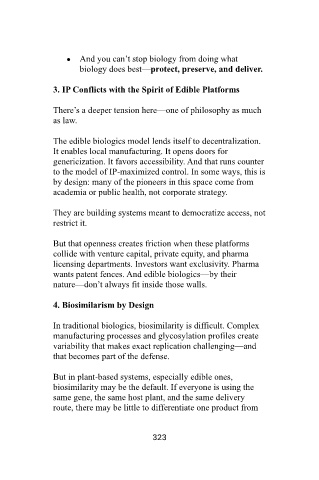Page 325 - Binder2
P. 325
● And you can’t stop biology from doing what
biology does best—protect, preserve, and deliver.
3. IP Conflicts with the Spirit of Edible Platforms
There’s a deeper tension here—one of philosophy as much
as law.
The edible biologics model lends itself to decentralization.
It enables local manufacturing. It opens doors for
genericization. It favors accessibility. And that runs counter
to the model of IP-maximized control. In some ways, this is
by design: many of the pioneers in this space come from
academia or public health, not corporate strategy.
They are building systems meant to democratize access, not
restrict it.
But that openness creates friction when these platforms
collide with venture capital, private equity, and pharma
licensing departments. Investors want exclusivity. Pharma
wants patent fences. And edible biologics—by their
nature—don’t always fit inside those walls.
4. Biosimilarism by Design
In traditional biologics, biosimilarity is difficult. Complex
manufacturing processes and glycosylation profiles create
variability that makes exact replication challenging—and
that becomes part of the defense.
But in plant-based systems, especially edible ones,
biosimilarity may be the default. If everyone is using the
same gene, the same host plant, and the same delivery
route, there may be little to differentiate one product from
323

